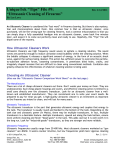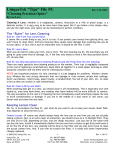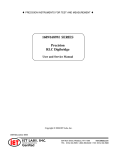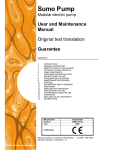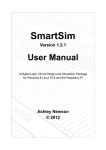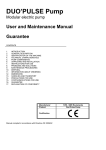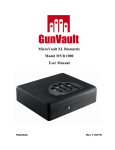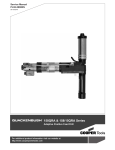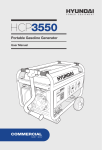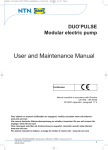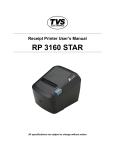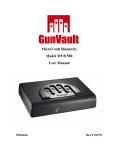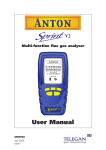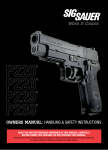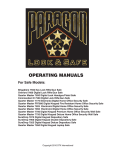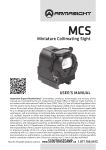Download Ultrasonic Cleaning of Firearms
Transcript
UniqueTek “Tips” File #9: Rev. 6; 07/2014 “Ultrasonic Cleaning of Firearms” By Lee Love An Ultrasonic Cleaner is considered the “last word” in firearms cleaning. But there is also mystery, fear and misconceptions about them. One common fear is that an ultrasonic cleaner, once purchased, will be the wrong type for cleaning firearms. And a common misconception is that you can simply drop a fully assembled handgun into an ultrasonic cleaner, come back five minutes later, and expect it to come out perfectly clean and ready to use. Hopefully, this “Tips” file will dispel some of the mystery. How Ultrasonic Cleaners Work Ultrasonic Cleaners use high frequency sound waves to agitate a cleaning solution. The sound waves are powerful enough to induce cavitation (small bubbles) within the cleaning solution. When the bubble collapses it releases a significant amount of energy, in the form of an acoustic shock wave, against the surface being cleaned. This action has sufficient power to overcome the particleto-substrate adhesion forces, loosening contaminants. It penetrates blind holes, cracks, and irregularly shaped recesses that are difficult to clean using conventional methods. Cavitation also greatly enhances the effectiveness of whatever cleaning solution is being used. Choosing An Ultrasonic Cleaner (Also see the “Ultrasonic Cleaner Comparison Work Sheet” on the last page.) The Manufacturer There are a lot of cheap ultrasonic cleaners out there. Don’t waste your money on them. They are underpowered, have cheap plastic housings and covers, and effective cleaning action is limited to a small zone directly over the ultrasonic transducer. Look for an ultrasonic cleaner from a wellknown and established manufacturer. They can recommend one to suite your exact needs. Be prepared to pay for what you get. A high-quality ultrasonic cleaner is an investment as important as the firearms you intend to clean, and will last for many years. Ultrasonic Transducers The ultrasonic transducer is the part that generates ultrasonic energy and couples that energy to the tank. The transducer is usually round and bonded to the bottom of the tank. Depending on the tank size and ultrasonic power (in Watts), there may be multiple transducers. In fact, multiple transducers are a desirable feature. Multiple transducers, spaced out along the tank bottom, ensure more uniform cleaning and fewer “dead spots” in the tank. This adds cost but it is well worth it in the long run. Look for “industrial-grade” transducers, as they are stronger and more reliable. Ultrasonic Frequency Ultrasonic frequencies usually range from 20–400 kHz. Most ultrasonic cleaners marketed as “gun © 2011-2014 UniqueTek, Inc. UniqueTek, Inc. 540 W. Iron Ave., Suite 118 Mesa, AZ 85210 -1Ph: 480-507-0866 Fax: 480-507-0867 Toll Free: 855-507-0866 Rev. 6 07/14 Email: [email protected] Web Sales: www.uniquetek.com cleaners” are 40kHz. It seems counter intuitive, but low frequencies yield more vigorous cleaning action than high frequencies. In fact, low frequency ultrasonic cleaners can be too rough on more delicate surfaces. High frequencies produce cavitation bubbles of smaller size that are better able to penetrate small cracks and blind holes. But cavitation bubbles at all frequencies are very small. Cavitation bubbles generated by a 40kHz ultrasonic cleaner are about 164µm in diameter (a human hair is roughly 90µm diameter). So, even at 40kHz, the cavitation bubbles are small enough to enter the smallest places in gun parts. Ultrasonic Frequency “Sweep” Mode Traditional ultrasonic systems use a single frequency. It is effective, but single frequency systems create dead spots and hot spots in the tank because of naturally occurring standing waves. “Sweep” mode is a small continuous variation of the ultrasonic frequency around a central value, such as 40kHz ±3 kHz. Sweeping the frequency prevents any single frequency from resonating in the tank, preventing standing waves, thus eliminating dead zones and hot spots. The end result is more uniform and somewhat faster cleaning. Sweep mode is used mostly for cleaning precision parts and surgical instruments, where highly uniform cleaning is needed, and probably not a critical feature for a gun cleaner. But Sweep mode is becoming a more common feature among better quality ultrasonic cleaners and may be standard on the cleaner you buy. Regardless, it is a feature to watch for when comparison-shopping for an ultrasonic cleaner. Ultrasonic Power and Tank Capacity Ultrasonic power and tank capacity are closely related. Ultrasonic cleaners are available with a wide variety of power ratings (in Watts) and tank capacities. Although the amount of power you need is dependent on a number of factors, tank capacity is probably the largest. In a larger tank, the ultrasonic energy is dispersed across the greater volume, reducing the power density. To completely immerse a full-size handgun will require a tank with approximately 4 to 6 Liter (1.0 to 1.5 Gallon) capacity. At this tank volume, 150 Watts is typical with 200 Watts as an available option on some units. Less than 150 Watts on this size tank will provide slow cleaning. Keep in mind that tank dimensions may be more important than tank capacity. A tank sized so that you can lay your handgun frame flat is preferred. But you can also prop it vertically, provided the tank is deep enough. Don't forget to take into account that the wire basket (see next section) will be slightly smaller than the tank dimensions. Wire Basket Ultrasonic cleaners usually come with a wire basket (often stainless steel) that fits into the tank. The basket is essential as it elevates parts off the tank bottom. Placing anything directly on the bottom of the tank prevents the ultrasonic transducers from oscillating and will damage the transducers. The general rule is to have at least 1/2" of space between the tank bottom and the basket. Most baskets hang from the rim of the tank and never touch the bottom at all. You may also find baskets that touch the tank at only a few points, usually in the far bottom corners of the tank, well away from the ultrasonic transducers. Avoid ultrasonic cleaners with a plastic basket, or no basket at all. NEVER operate the ultrasonic cleaner with anything lying directly on the tank bottom! ALWAYS use the wire basket! © 2011-2014 UniqueTek, Inc. UniqueTek, Inc. 540 W. Iron Ave, Suite 118 Mesa, AZ 85210 -2Ph: 480-507-0866 Fax: 480-507-0867 Toll Free: 855-507-0866 Rev. 6 07/14 Email: [email protected] Web Sales: www.uniquetek.com To protect the finish on your guns from rubbing against the metal basket, some ultrasonic cleaners come with a plastic plate (or it may be available as an option) that lies in the bottom of the basket. TIP: Misplaced the plastic plate? A piece of fiberglass mosquito screen laid in the bottom of the basket will work in a pinch! The ultrasonic energy will degrade it over time, but it is cheap and easily found. If you want a longer lasting solution, you can buy polyethylene screen from McMaster Carr ( http://www.mcmaster.com/ - plastic-mesh-screens/=jkb228 ). It will survive the ultrasonic cleaning action longer and is more resistant to the ultrasonic cleaning chemicals. TIP: Mosquito screen or polyethylene screen can also be used to prevent small parts (e.g. screws, pins, etc.) from falling through wire baskets that have a coarse mesh. Timer A built-in timer is a very good feature to look for. With a timer, you can turn your attention to other tasks (such as preparing the next firearm for cleaning) and not have to “watch the clock”. TIP: If your ultrasonic cleaner doesn’t have a built-in timer, a simple kitchen timer will get the job done, but will not automatically shut off the ultrasonic cleaner. A countdown power timer (e.g. UniqueTek’s Time-Out™ Timer) will give you to-the-minute control and assurance that you can’t get distracted and accidentally leave the ultrasonic turned on. Heated Tank A heated tank is essential. Many cleaning solutions require elevated operating temperatures to be effective. One commercial cleaning solution I’ve used requires a temperature of 145°F (63°C) and cleaning activity is markedly reduced below that temperature. Make sure the heater is capable of reaching the temperature required for the cleaning solution you choose. Although the ultrasonic energy alone will cause some heating of the cleaning solution, it is slow and may never reach the desired operating temperature. The additional cost for a heated tank is not that much more and worth every penny. A heater with thermostatic temperature control is even better as it will maintain a constant temperature. Hotter is not better. When temperatures exceed 60°—70°C (140°—158°F) the effectiveness of decavitaion (bubble collapse) is greatly reduced, thus decreasing cleaning effectiveness. This is because the bubbles will be filled with vapor instead of being essentially a vacuum … so the bubble can’t collapse as energetically, reducing cleaning action. So a maximum temperature setting of 70°C is typical. NOTE: Check the recommended use temperature of all ultrasonic cleaning solutions before use. NEVER use any ultrasonic cleaning solution above its recommend temperature. Bottom Drain A bottom drain is handy when it comes time to change cleaning solution, but you will pay a premium for this feature. Bottom drains are not a common feature on tabletop ultrasonic cleaners. Up to about 1.5gal (6L) capacity they are not too heavy to just pick up and pour out. Some even come with handles on the side to make this easier. © 2011-2014 UniqueTek, Inc. UniqueTek, Inc. 540 W. Iron Ave, Suite 118 Mesa, AZ 85210 -3Ph: 480-507-0866 Fax: 480-507-0867 Toll Free: 855-507-0866 Rev. 6 07/14 Email: [email protected] Web Sales: www.uniquetek.com A bottom drain can have drawbacks. A drain is a potential leak waiting to happen. A valve that leaks, or just doesn’t get closed tightly, can drain a tank overnight. Look for a drain tube that is welded to the tank (a gasket will eventually leak) and that has a stainless steel ball valve. A poorly designed drain can also dampen the ultrasonic energy in that immediate area. Tank Cover A tank cover is essential and most ultrasonic cleaners will come with one. Keeping the tank covered greatly minimizes evaporation of cleaning solution and minimizes fumes. Look for covers (and tanks) made from stainless steel, as it is more sturdy and chemical resistant. Plastic covers should be avoided, as they are handled frequently and thus prone to breakage. TIP: If you have a cleaner without a cover, some heavy-duty aluminum foil will get the job done (assuming the cleaning solution is compatible with aluminum). In the long run, you may want to get a cover made at a local sheet metal fabricator shop. Materials of Construction High quality ultrasonic cleaners will have a metal housing, not plastic! They will also be heavy since heavy-duty power supplies, industrial-grade transducers, sheet metal housings and associated hardware all add weight. You can expect a high quality cleaner with 1-gallon capacity to weigh in at close to 10 pounds! Manufacturer’s Warrantee Don’t forget to ask about the manufacturer’s warrantee, especially if you don’t buy direct from the manufacturer. Warrantee terms vary greatly from one manufacturer to the next. Ultrasonic Cleaning Solutions The choice of cleaning solution will greatly affect the results you will obtain with any ultrasonic cleaner, and the correct cleaning solution is very dependent upon the item being cleaned. Water alone is not a very efficient cleaning solution unless it contains surfactants, detergents or other additives. Water-based cleaning solutions are also somewhat more limited in their ability to remove contaminants by chemical action alone compared to solvent solutions; e.g. for parts covered with thick grease. There are many industrial ultrasonic cleaning solutions, and virtually every ultrasonic cleaner manufacturer has its own line of products. There are far too many to list here. Be very careful with your selection as cleaning solutions can contain acids, ammonia or other harsh chemicals that could potentially damage gun finishes. The best recommendation is to call the manufacturer and ask for a recommendation … and make sure to tell them exactly what you are cleaning. Don’t forget that you may need more than one cleaning solution to cover all of your needs (e.g. one for cleaning firearms and a different one for cleaning brass). Keep in mind that any cleaning solution that will attack gun finishes or plastic parts will attack faster in an ultrasonic cleaner. So be very careful, especially with “home grown” cleaning solutions. For example, Simple Green will corrode aluminum when used in ultrasonic cleaners. © 2011-2014 UniqueTek, Inc. UniqueTek, Inc. 540 W. Iron Ave, Suite 118 Mesa, AZ 85210 -4Ph: 480-507-0866 Fax: 480-507-0867 Toll Free: 855-507-0866 Rev. 6 07/14 Email: [email protected] Web Sales: www.uniquetek.com Aqueous Cleaning Solutions Aqueous (water based) cleaning solutions are currently the most widely used type in industrial applications. They usually come as a concentrate that you mix with water before use, and contain surfactants, detergents, corrosion inhibitors and other additives. They can be formulated to be alkali, acidic or neutral pH depending on the contamination you are trying to remove and the substrate material. Most modern aqueous cleaning solutions are more environmentally friendly than solvent-based cleaners. Always use distilled or reverse osmosis water and not tap water. Tap water contains far too many minerals that you don’t want in the mix. Organic Solvent Cleaning Solutions Organic Solvent cleaning solutions are less popular due to environmental concerns as well as concerns for their flammability. You do have to be careful with solvents, as most small ultrasonic cleaners are not explosion proofed. Even without a heating element the ultrasonic energy will cause some heating of the solvent, especially during long cleaning cycles. Some cleaning solutions Adequate ventilation should be provided and the tank should be kept covered at all times to minimize evaporation. You also need to be more careful about materials compatibility with solvent cleaning solutions as ultrasonic cleaners can greatly accelerate their attack on plastics. A solvent that you used successfully for just a “spray-n-wipe” cleaning may completely melt the same material when used in an ultrasonic cleaner. I personally prefer solvent-based cleaning solutions versus aqueous cleaners due to concerns about corrosion. In my mind, water and steel just don’t go together. Solvent-based cleaners readily evaporate after the parts are removed from the cleaner without rinsing and drying. However, you still MUST LUBRICATE IMMEDIATELY after cleaning to prevent rust. NEVER use gasoline or other highly flammable materials as a cleaning solvent in any ultrasonic cleaner, even one that has an “explosion proof” rating! NOTE: Check the recommended use temperature of all ultrasonic cleaning solutions before use. NEVER use any ultrasonic cleaning solution above its recommend temperature. More Things To Know About Ultrasonic Cleaning NEVER Operate When Empty Or Low Never run an ultrasonic when empty or low … not even for just a few seconds! This can instantly damage the ultrasonic transducer. With the tank empty, there is no place for the ultrasonic energy to go. It is also generally not recommended to run the ultrasonic cleaner with no parts in the tank. Always keep the cleaning solution within the recommended level. Many ultrasonic cleaners have minimum and maximum fill levels marked directly on the tank wall. Always Use The Wire Basket Always use the wire basket to elevate parts off the tank bottom. Never place anything directly on the bottom of the tank as this prevents the ultrasonic transducer from oscillating and will damage the transducer. © 2011-2014 UniqueTek, Inc. UniqueTek, Inc. 540 W. Iron Ave, Suite 118 Mesa, AZ 85210 -5Ph: 480-507-0866 Fax: 480-507-0867 Toll Free: 855-507-0866 Rev. 6 07/14 Email: [email protected] Web Sales: www.uniquetek.com Also use the wire basket to support jars of cleaning solution and lubricating solution when doing “indirect” cleaning. (Indirect cleaning is described in the next section.) Direct Versus Indirect Cleaning “Direct” cleaning is when you fill the ultrasonic cleaner tank with cleaning solution. “Indirect” cleaning is when you fill the tank with plain water then place a smaller container, filled with your desired cleaning solution, in the basket. Indirect cleaning can save a lot of cost in cleaning solution, as you don’t need to fill the entire tank. It can also save a lot of time if you change cleaning solutions frequently, as you will not need to drain the tank each time. If you are only cleaning a few small parts, you can have two containers in the ultrasonic cleaner at the same time … one for cleaning solution and one for lubricating solution. This is also handy if your ultrasonic cleaner tank doesn’t have a bottom drain. The down side is that it significantly reduces the size of parts that can be cleaned. It will also take a bit longer for the cleaning solution to come up to temperature. NOTE: Always place indirect cleaning containers in the wire basket and not directly on the bottom of the tank. NOTE: Always turn off the ultrasonic before removing the containers from the tank. When you lift the containers out, the water level may drop below the minimum level and could damage the transducer. TIP: To maximize the efficiency of coupling ultrasonic energy into the container, adjust the cleaning solution level so it is the same as the water level in the tank. TIP: Use wide-mouth jars with screw-on lids for indirect cleaning containers. When finished, you can screw on the lid to preserve the cleaning or lubricating solutions for reuse. During cleaning, leave the lids off (or on loosely to minimize evaporation) so that pressure can’t build up inside the jars. Degassing Cavitation bubbles are not filled with air, but are essentially a vacuum (with some vapor from the cleaning solution). In fact, dissolved gasses reduce the power and effectiveness of ultrasonic cleaners, so running the ultrasonic cleaner for a short period to “degas” the solution is often recommended. During degassing, you can usually see bubbles form and rise to the surface. Once a cleaning solution or lubricating solution has been degassed, it will not need degassing again until it is changed or when fresh cleaning solution is added to make up for evaporation. Check the ultrasonic cleaner user manual and the cleaning solution instructions for how long to degas. It can take anywhere from just a few minutes to 30 minutes depending on the ultrasonic cleaner, cleaning solution and tank size. With tank sizes commonly used for cleaning firearms, 5 minutes is typical. Some ultrasonic cleaners have a built-in degas function. It is a feature to look for, but not a deal killer if it is absent. © 2011-2014 UniqueTek, Inc. UniqueTek, Inc. 540 W. Iron Ave, Suite 118 Mesa, AZ 85210 -6Ph: 480-507-0866 Fax: 480-507-0867 Toll Free: 855-507-0866 Rev. 6 07/14 Email: [email protected] Web Sales: www.uniquetek.com Removing Excess Cleaning Solution From Parts After cleaning, any residual cleaning solution or rinse water should be thoroughly removed from all parts. Towel drying with clean cotton towels is a good start. Compressed air and a blow dryer (for hair) are great accessories to assist with this task. Canned air is ok for smaller jobs and places you don’t want much force, but a small air compressor can achieve higher pressure, greater volume of air, and won’t run out just when you need it. The hair dryer is handy as it warms the parts and greatly speeds drying. CAUTION: Remember to wear safety glasses, especially when blowing off parts! TIP: Buy a cookie sheet (a 1/2 Sheet Pan is 18"x13") and place an old bath towel on it and use it as a place to drain and blow off the parts after removing from the ultrasonic cleaner. Any pan about the size of a cafeteria tray is the right size for most handguns and parts that will fit into the tank. In fact, an old cafeteria tray, if you can find one, is good. Try a restaurant supply outlet as they usually have heavy-duty products at reasonable prices. TIP: Unlike a deep fat fryer, small ultrasonic cleaners don’t have a place to hang the basket to allow solution to drain back into the tank while you are removing cleaned parts. A small cookie sheet makes a great place to rest the basket, as it will collect the drips. Just pour the captured solution back into the tank when done. I found an inexpensive Brownie Pan (11.0"L x 7.0"W x 1.5"H) that was a perfect fit for the basket in my ultrasonic cleaner. Lubricate Immediately After Cleaning! Ultrasonic cleaners are so efficient they clean out the microscopic pores in the metal. To prevent rust, you must ALWAYS IMMEDIATELY LUBRICATE all parts after ultrasonic cleaning. It doesn’t matter if you used an aqueous or solvent based cleaner. Ultrasonic lubrication is primarily intended to inhibit rust by getting oil back onto the now clean metal. Yes, you can apply your favorite lubricant(s) by hand, but lubricating in the ultrasonic tank is far superior as the ultrasonic action helps get the lubricating solution deep into the metal pores. You will notice that I said “lubricating solution” not “oil”. The lubricating solutions recommended for ultrasonic gun cleaning are specially formulated for this purpose. They are mostly oil, but may also contain water displacement additives and corrosion inhibitors that are essential if you use an aqueous cleaning solution or any solution that requires a water rinse. They are also low viscosity so that they can easily penetrate into small pores in the metal. Unfortunately, some ultrasonic lubricating solutions contain solvents (e.g. xylenes) that could damage plastics and polymer frames. Check with the manufacturer and be as specific as possible about the materials you will be lubricating. Requesting an MSDS is also a good idea. You should also check the directions to see if the lubricating solution is to be used at room temperature or heated. Lubricating solutions are generally used at full strength. Never dilute unless the manufacturer specifically recommends it. Professional gun-cleaning services often use two ultrasonic cleaners; one filled with cleaning solution, and one filled with a special lubricating solution. You can easily accomplish the same thing with a single ultrasonic cleaner by using the “indirect” cleaning technique and filling one container with cleaning solution and a filling a second container with lubricating solution. If your tank is too small for this, you will need to drain the cleaning solution and refill the tank with lubricating solution. © 2011-2014 UniqueTek, Inc. UniqueTek, Inc. 540 W. Iron Ave, Suite 118 Mesa, AZ 85210 -7Ph: 480-507-0866 Fax: 480-507-0867 Toll Free: 855-507-0866 Rev. 6 07/14 Email: [email protected] Web Sales: www.uniquetek.com TIP: The more thoroughly you dry parts before immersing in lubricating solution, the more times the lubricating solution can be reused. Don’t forget that the ultrasonic lubrication solution is simply a corrosion prevention measure. After ultrasonic lubrication, you will be blowing off any excess and giving every part a thorough wipe down. You will then need to apply your favorite lubricant(s) to all the same lubrication points on the firearm. The up side of all this is that whatever lubricants you use, will tend to get a better “grip” on the metal and work better since the metal pores aren’t contaminated with old lube, carbon, grit, etc. Just How Long Can I Delay Between Cleaning and Lubricating? Good question. It all depends on just what finish (if any) is on the metal. With stainless steel, and corrosion resistant coatings (e.g. Tenifer, NP3, Nickel, Cerakote, etc.), delaying several hours should not be a problem because the metal is protected. But raw steel finishes can develop a blush of surface rust almost immediately. That is why gunsmiths who offer ultrasonic cleaning as a service usually have two ultrasonic cleaners ... One for cleaning and the second for lubricating. They never need to wait between cleaning and lubricating. If you have only one ultrasonic cleaner, special "lube tanks" are available that float on top of the cleaning solution in the ultrasonic cleaner. The ultrasonic energy transmits up through the lube tank bottom. Yes you do loose a substantial amount of ultrasonic energy this way, but it allows you to be ultrasonically lubricating the first gun at the same time as you are cleaning a second. Lube tanks, assuming one is available for your model ultrasonic cleaner, tend to be a bit pricy for what they are, but are still much less expensive than buying a second ultrasonic cleaner. TIP: If you have only one ultrasonic cleaner, and no lube tank, you can immerse the cleaned parts in a pan of lubricating solution while waiting for the more parts to come out of the ultrasonic cleaner. This will protect them from rusting until you can drain the ultrasonic tank and fill it with lubricating solution … then ultrasonically lubricate them all at once. TIP: When cleaning smaller gun parts, I always use "indirect" cleaning. I fill the ultrasonic cleaner with plain water, and then fill smaller jars (mayonnaise, peanut butter, etc.), one with cleaning solution and another with lubricating solution, and set them in the wire basket. Swapping the jars (if both don't fit at the same time) takes just seconds. Ok. Let's say I'm going to clean my S&W Model 19 Revolver, which takes up the full tank. So indirect cleaning is not practical. It is nickel-plated and has hard polymer grips, which are impervious to rust. But the cylinder chambers and the bore are raw steel. Well, as soon as the bore is dry, I immediately run a Bore-tip™ bore swab, saturated with the ultrasonic lubricating solution, down the bore and into each chamber of the cylinder. Now I can take my time ultrasonic cleaning the remaining parts. Of course, you could also use any lightweight gun oil, but be sure to use a very lightweight oil that will not present a barrier to the ultrasonic lubricating solution. This is all one more example of why I prefer a solvent gun cleaner instead of a water based cleaner. A solvent cleaner does not need rinsing and is usually miscible with lubricating solutions. If I'm seriously worried about the possibility of even the lightest blush of rust, I can go directly front the cleaning tank to the lubrication tank with little more than a few seconds wait for the parts to © 2011-2014 UniqueTek, Inc. UniqueTek, Inc. 540 W. Iron Ave, Suite 118 Mesa, AZ 85210 -8Ph: 480-507-0866 Fax: 480-507-0867 Toll Free: 855-507-0866 Rev. 6 07/14 Email: [email protected] Web Sales: www.uniquetek.com drip off. Of course this practice does tend to transfer more contaminants into the lubricating solution, shortening its life. Recover And Reuse Chemicals Recover and store the lubricating solution from the tank. Since it is used straight from the jug, you can simply return it to its original jug for later use. Remember, the cleaner you keep the lubricating solution, the more times it can be reused. Lubricating solution can be reused many times if it is kept clean. TIP: If your ultrasonic cleaner has a drain, be sure to thoroughly purge cleaning solution and dirt from the drain tube and valve before filling with lubricating solution. Anything left behind will just contaminate the lubricating solution, shortening its life. It may not be possible or practical to save and reuse the cleaning solution. Most aqueous cleaning solutions are concentrates that are mixed with water before use, so you will not be able to return them to the original container. They also tend to become exhausted quickly and saving them may not be recommended. Check the manufacturer’s instructions. Organic solvent cleaning solutions are typically used without dilution or additives, so it may be acceptable to save and reuse them. During use, some solvents in the formulation may evaporate quickly, reducing the effectiveness of the solution. Again, check the manufacturer’s instructions. One exception is UniqueTek Premium Firearms Cleaner™. It does not change composition due to evaporation and can be reused many times without loosing effectiveness … especially if filtered when drained back into the jug. TIP: Use a coffee filter to filter lubricating solution or cleaning solution when returning to the jug. Coffee filters are effective, easy to find and cheap! © 2011-2014 UniqueTek, Inc. UniqueTek, Inc. 540 W. Iron Ave, Suite 118 Mesa, AZ 85210 -9Ph: 480-507-0866 Fax: 480-507-0867 Toll Free: 855-507-0866 Rev. 6 07/14 Email: [email protected] Web Sales: www.uniquetek.com Safety Keep Your Fingers Out Of The Tank! Never place your fingers into the tank when the ultrasonic is turned on. The ultrasonic energy can generate bubbles in your joints and veins and is also bad for your bones. Wear Gloves! The cleaning solution(s) you use may recommend that you avoid skin contact. Wearing gloves will protect your hands from the cleaning solution … but not from the ultrasonic energy. So don’t be tempted to reach into the tank with the ultrasonic on even when wearing gloves. Read the cleaning solution instructions or MSDS or call the manufacturer for a recommended glove material. TIP: When in doubt, Nitrile gloves are a good bet as they are resistant to a broader range of chemicals than most other glove materials. Wear Safety Glasses! Wear safety glasses to avoid getting cleaning solution or lubricating solution into your eyes. Ultrasonic cleaners shouldn’t generate any splashing on their own, but accidentally dropping a part into the tank will. And blowing off parts can cast a lot of mist into the air. Ventilation! Good ventilation is always a good idea, but may be essential depending on the cleaning solution(s) you choose. Always read the manufacturer’s instructions. MSDS! You should always request the MSDS (Material Safety Data Sheet) for each of the cleaning and lubricating solutions, and read them prior to use. The MSDS contains detailed information on the chemicals in each solution as well as safety and first aid information. TIP: You can request a copy of the MSDS prior to purchasing the product. Product Instructions! You should always read the product instructions, for each of the cleaning and lubricating solutions, prior to use. The instructions will contain detailed information on the recommended dilution ratio, operating temperature, rinsing instructions, etc. TIP: Request a copy of the product instructions and read it prior to purchasing the product. This may save you of buying a product that is not recommended for your specific needs. The instructions often contain important safety information (e.g. recommended type of gloves). © 2011-2014 UniqueTek, Inc. UniqueTek, Inc. 540 W. Iron Ave, Suite 118 Mesa, AZ 85210 - 10 Ph: 480-507-0866 Fax: 480-507-0867 Toll Free: 855-507-0866 Rev. 6 07/14 Email: [email protected] Web Sales: www.uniquetek.com Preparing A Firearm For Ultrasonic Cleaning In a word; disassemble! You simply cannot expect any cleaning method, not even an ultrasonic cleaner, to effectively clean a fully assembled firearm. There are just too many confined spaces for the cleaning solvent to easily flow through and for residues to be flushed out. In particular, cleaning between tightly fitted parts (e.g. a pivot hole and shaft) is difficult even for an ultrasonic cleaner. That said, there are times when you either can’t disassemble something any further or don’t want to risk further disassembly. In that case you should be prepared to put that part through longer cleaning cycles and/or repeated cleaning cycles to achieve complete cleaning. Obviously, you must unload and remove all ammunition. And you must remove wood grips, soft rubber grips, optics and any other parts that are not compatible with either the cleaning solution or with ultrasonic cleaning in general. But you should also consider such things as Tritium night sights. If there is any doubt, a call to the manufacturer is recommended. Field strip at minimum. If further disassembly is possible, it can significantly shorten the ultrasonic cleaning time and also make it much easier to ensure that all the cleaning solution has been rinsed away and the parts are completely dry before lubrication. It is also a good idea to detail strip the slide periodically for a more thorough cleaning and inspection. On many firearms, detail stripping the frame can be too difficult to be practical. Just disassemble as far as is practical, be thorough with the clean, rinse and lubrication steps, and it will still come out cleaner that what you could accomplish without ultrasonic cleaning. Semi-Automatic Pistols • Field strip according to manufacturer’s instructions. • Remove grips (if possible). Revolvers • Remove grips. • Place hammer in cocked position (when possible). • Remove side plate. • Remove cylinder (and separate cylinder from crane if applicable). • Place a small spacer (a spent cartridge case works) under the extractor star. TIP: Swab the bore with a good defouler, allow to soak for a few minutes, then run a bore brush several passes through. This will reduce ultrasonic cleaning time and yield improved results over ultrasonic cleaning alone. To save time, his can be done while waiting for the cleaning solution to come to temperature. © 2011-2014 UniqueTek, Inc. UniqueTek, Inc. 540 W. Iron Ave, Suite 118 Mesa, AZ 85210 - 11 Ph: 480-507-0866 Fax: 480-507-0867 Toll Free: 855-507-0866 Rev. 6 07/14 Email: [email protected] Web Sales: www.uniquetek.com Preparing Ultrasonic Cleaner For Cleaning Firearms Step 1: Check that ultrasonic cleaner tank is clean. Wipe out any residue. Step 2: Fill ultrasonic cleaner tank with cleaning solution. Step 3: Turn on heater and set to recommended temperature. Allow enough time for cleaning solution to come to temperature. If the ultrasonic cleaner doesn’t have a display that shows that actual temperature, use a thermometer. Keeping the tank covered will speed up heating. Step 4: Degas the cleaning solution (Not necessary if previously done to this batch of cleaning solution or lubrication solution) Steps For Ultrasonic Cleaning A Firearm Step 1: Field strip the firearm. Step 2: Swab the bore with a good defouler and allow to soak for a few minutes, then run a bore brush several passes through. Step 3: Place the firearm in the basket. Be sure to also use a plastic tray to prevent direct contact between the firearm and metal basket. Step 4: Lower the basket into the ultrasonic cleaner bath. Step 5: Set cleaning time (5 to 30 minutes depending on how dirty the firearm is) and turn on ultrasonic cleaner. Step 6: Check firearm periodically for cleanliness. Step 7: When clean, turn off ultrasonic and heater. Step 8: Lift the basket from the tank. Allow a few seconds for excess cleaning solution to drain back into the tank. Step 9: Rinse each part with water (or whatever is recommend). If water is recommended, using warm water will speed drying. If you are using a solvent based cleaning solution, rinsing may not be required and you may only need to set the firearm aside to air dry. Step 10: Blow off as much water as possible with an air compressor or canned air. Pay special attention to confined spaces where water may be trapped. Step 11: ALWAYS IMMEDIAELY LUBRICATE FIREARMS AFTER CLEANING! (See following Section) Steps For Lubricating A Firearm If you are using a single-tank ultrasonic system, you will need to remove the cleaning solution, clean the tank, and replace it with lubricating solution. If heating is required, allow lubricating solution to come to temperature before proceeding. Step 1: Ensure that the firearm has been thoroughly rinsed and as much excess water as possible has been removed. Step 2: Place the firearm in the basket. Be sure to use a plastic tray to prevent direct contact between the firearm and metal basket. Step 3: Lower the basket into the ultrasonic cleaner bath. Step 4: Set cleaning time to 5 minutes and turn on ultrasonic cleaner. Step 5: Turn off ultrasonic (and heater if used). Step 6: Lift the basket from the tank. Allow a few seconds for excess lubricating solution to drain back into the tank. (Continued on next page.) © 2011-2014 UniqueTek, Inc. UniqueTek, Inc. 540 W. Iron Ave, Suite 118 Mesa, AZ 85210 - 12 Ph: 480-507-0866 Fax: 480-507-0867 Toll Free: 855-507-0866 Rev. 6 07/14 Email: [email protected] Web Sales: www.uniquetek.com Step 7: Wipe down all parts with a clean cloth to absorb excess lubricating solution. Do not wipe excessively as you want to leave a thin coating of lubricant on the parts. Use an air compressor or canned air to blow excess lubricating solution out of confined spaces. Reassemble Firearm Step 1: Thoroughly inspect all parts. As they will be very clean, now is the best time to inspect for wear, cracks or other problems and take corrective action. Step 2: Lubricate all points as recommended by the firearm manufacturer using the appropriate lubricants. The lubricating solution alone may not be the best choice for all lubrication points. Step 3: Complete firearm assembly according to the manufacturer’s instructions. Cleaning Rifles and Shotguns You will undoubtedly have noticed that I have not mentioned anything about cleaning rifles or shotguns. That is because ultrasonic cleaners large enough to immerse an entire barrel are too expensive and take up too much space for the average gun owner. However, all of the information contained herein is applicable to ultrasonic cleaning of long guns. TIP: Although you can’t immerse an entire barrel/receiver assembly in an ultrasonic cleaner tank sized for cleaning handguns, you can suspend the barrel above the tank so that just the receiver is fully immersed. That leaves only the bore to be cleaned using conventional cleaning methods. Final Thoughts Choosing the right ultrasonic cleaner for your needs, and then using it to properly and safely clean your firearms, may sound like a daunting task. But with a little knowledge and preparation, the selection process will be easier, and you will find ultrasonic cleaning to be an efficient and effective way of protecting your firearms investment. Simple Green is a trademark of Sunshine Makers, Inc. Premium Firearms Cleaner and Time-Out are trademarks of UniqueTek, Inc. © 2011-2014 UniqueTek, Inc. UniqueTek, Inc. 540 W. Iron Ave, Suite 118 Mesa, AZ 85210 - 13 Ph: 480-507-0866 Fax: 480-507-0867 Toll Free: 855-507-0866 Rev. 6 07/14 Email: [email protected] Web Sales: www.uniquetek.com Ultrasonic Cleaner Comparison Work Sheet The table below has a list of features to consider when purchasing an ultrasonic cleaner. Fill in the information for each ultrasonic cleaner you are considering and it will be easier to determine which unit to choose. Manufacturer Ultrasonic — Power (Watts) — Frequency (kHz) — Sweep Mode (Yes/No) — Number of Transducers Timer — (Yes/No) — Type (Digital/Analog Dial) — Range (minutes) — Degas Function (Yes/No) Tank — Dimensions (LxWxDepth) — Capacity (gal/liter) — Cover (Yes/No) — Cover Material (Metal/Plastic) Basket — Included (Yes/No) — Material (Stainless Steel, other?) — Basket Dimensions (LxWxD) — Basket Liner (Yes/No) Heater — (Yes/No) — Heater Power (Watts) — Temperature Range (°F/°C) — Thermostat (Yes/No) Drain — (Yes/No) — SS Ball Valve (Yes/No) Housing — Sheet Metal or Plastic? — Lifting Handles? (Yes/No) Weight Other Included Accessories Warrantee (Yrs) Cost © 2011-2014 UniqueTek, Inc. UniqueTek, Inc. 540 W. Iron Ave, Suite 118 Mesa, AZ 85210 - 14 Ph: 480-507-0866 Fax: 480-507-0867 Toll Free: 855-507-0866 Rev. 6 07/14 Email: [email protected] Web Sales: www.uniquetek.com














